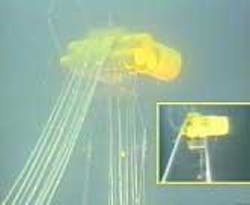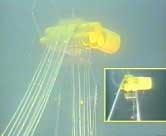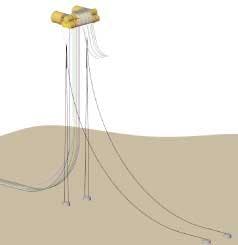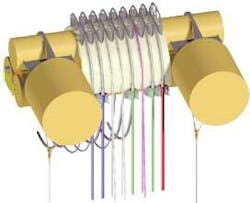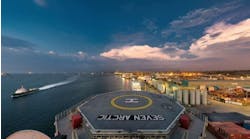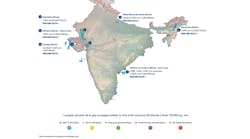Mid-water arch supports weight
SEAL Engineering, a subsidiary of Technip, is developing a new riser con- cept for ultra-deepwater applications. The Hybrid S Riser system (HySR) is designed to reduce loads transmitted by the riser onto the floating production platform. The system also addresses fatigue typically incurred at the sag bend of steel catenary risers (SCRs) close to the seabed touch-down point. These issues have created serious concerns and cost overruns, in terms of engineering manhours, at several high-profile deepwater field developments.
The HySR comprises a buoyant mid-water arch connected to seabed foundations by two dual-redundant taut tethers and two catenary restraining tethers. SCRs and flexible riser jumpers transport fluids between the subsea flowlines and the floating production unit (FPU).
null
The main role of the subsea arch is to support the different risers while facilitating FPU motion de-coupling. Its main components are three long air cans, which provide system buoyancy, and two side cans that serve to balance the SCR loads and tilting moment. A large radius arch tray supports the flexible jumpers, also allowing coiled tubing access from the FPU deck.
Incorporated in the arch is a control and integrity monitoring system that includes three main devices. Accelerometers allow the arch's motions (displacements, rotations) to be recorded; stress gauges situated on the bridle pad-eyes monitor the tether tension performance, and an acoustic data transmitter provides for periodic downloading of recorded data.
Two tether and foundation systems anchor the subsea arch to the seabed. Each of these systems features:
- A structural connection comprising double wall steel plates with two tie-rods connected to the arch
- Dual taut tethers transmitting the arch's net uplift tension to the foundation (suction anchor)
- A catenary restraining tether, anchored to the seabed by a pile, which restricts the subsea arch's excursions.
null
According to SEAL, based in Nimes, south- ern France, the HySR offers numerous advan- tages over competing riser concepts. These include:
- Use of a subsea arch removes the weight penalty introduced by SCR loads at the FPU deck, thereby improving payload and allowing the specification of riser pull-in equipment to be reduced
- Riser fatigue caused by wave-induced motions on the FPU is minimized or eliminated – the same applies to current vortex-induced vibrations, riser ratcheting at the seabed, and stresses caused by soil suction at the riser touch-down zones. This is partly because seabed anchors are not required for the SCRs
- Compared to a riser tower, the HySR's flowline/riser configuration provides a smooth flow path, reducing slugging risk, with minimal intermediate connections also cutting potential for leak points
- The system allows all flowlines, risers, and umbilicals to be pre-installed and commissioned prior to the arrival on-site of the FPU. This eliminates the need to mobilize extra equipment to the FPU for flowline flooding, gauging, pressure tests, and de-watering.
Model tests
SEAL performed two sets of basin tests based on West African storm conditions and a buoy located 100 m below sea level. The company conducted the first tests on a 1:30 scale model of the HySR's subsea arch at the Force facility in Denmark. Here, SEAL tested three configurations of the arch with and without a heave plate, positioned 3 m and 6 m below the main cans.
The company performed dynamic free oscillation tests in three directions to measure dynamic added mass and quadratic damping coefficients. SEAL also tested towing for all three X, Y, and Z directions to measure the arch's static drag. The results confirmed the arch's various hydrodynamic coefficients, and these were then used to calibrate the dynamic analysis models and the full HySR basin test models.
SEAL also performed a series of dynamic tests at the Marin basin in The Netherlands on a 1:60 scale model. This system was partly truncated to achieve a satisfactory compromise between the water depth at this facility and a realistic model scale. The company also used Marin's deepwater pit to model the taut tethers over the entire water depth (the latter not truncated).
Results from these tests suggested that the HySR arch exhibits a stable behavior and is not susceptible to large wave-induced motions at the design depth of submersion (1,000 m). During one of the trials, a long-period wave created specifically to excite the heave natural period showed just a small degree of heave motion magnification at the arch level. The test team then investigated the potential for manual adjustment of the system's hydrodynamic characteristics through the installation of heave plates at various levels below the subsea arch. Their conclusion was that this concept is feasible, if required for certain field applications in order to modify the system's added mass and damping.
According to SEAL, comparisons with numerical results for buoy heave motion demonstrated the accuracy of the analytical model in representing the system's behavior. Discrepancies were limited generally to smaller wave responses (i.e. 100 mm full-scale displacement for a 1,250 m depth HySR).
Numerical analyses
SEAL also performed a series of analyses for environmental conditions off West Africa and Brazil, using non-linear time domain analysis software. For developments offshore Angola, the company modeled an HySR system in a water depth of 1,250 m, with a mean distance of 250 m separating the subsea arch from the FPSO. The arch was 100 m below sea level with the tether foundation systems 90 m apart. SEAL configured the system for eight risers.
For safety purposes, SEAL considered dual-redundant tethers for the tether foundation system. Taut tethers were polyester ropes with a minimum breaking load (MBL) of 400 tons each. Restraining tethers comprised chains for the bottom section and polyester ropes with an MBL of 630 tons for the upper part. The company chose polyester ropes for their low axial stiffness, which results in a longer natural period for the system, and fortheir higher performance fatigue characteristics.
The dynamic and fatigue analyses confirmed the feasibility and robustness of the proposed HySR. The decoupling of FPSO and subsea arch motions confirmed that SCR motions at touch-down would be minimized, thereby eliminating SCR fatigue concerns. (The set criteria included a fatigue life of at least 250 years for the SCRs and tethers, equivalent to a 25-year design service life with a safety factor of 10).
The study also confirmed that all the HySR's mechanical and structural aspects met familiar design practices (API, DNV). Analysis of the tether system proved compliance with API rules and showed that the tethers are always in tension, thereby avoiding the risk of 'snatch' loads. SEAL also verified minimum clearances between risers and observed no riser/riser or riser/umbilical clashing.
For the Brazil study, the company modeled a system for a water depth of 1,800 m, with a mean distance of 300 m separating the subsea arch from the FPU. SEAL spaced the tether foundation systems 90 m apart. Due to Brazilian environmental conditions – typically high wave amplitude and frequent long period waves – the company positioned the subsea arch 150 m below sea level, with polyester ropes selected for the taut tethers.
SEAL considered dual- redundant taut tethers for the tether foundation system. Taut tethers were polyester ropes with an MBL of 1,250 tons. Restraining tethers comprised chains at the bottom part and polyester ropes at the upper part with an MBL of 1,100 tons.
Storm, fatigue, and riser clashing analyses confirmed the system's mechanical and structural integrity for Brazil applications (API, DNV). SCR and tether fatigue life was above the 250-year requirement. Maximum tether tensions complied with API criteria for all loading and sensitivity conditions. Analysis confirmed that the tethers were in load tension for all load case. SEAL also verified minimum clearances were also verified for critical load cases between the mooring lines, HySR system, riser/riser, and riser/umbilical.
